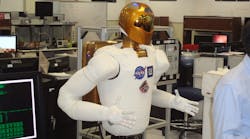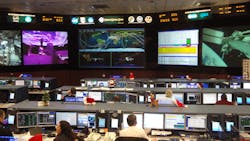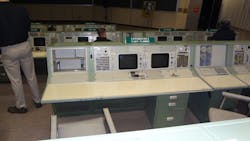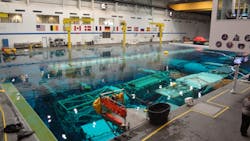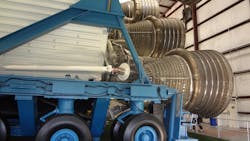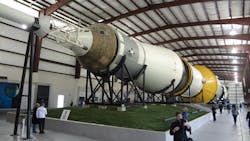It is easy to jaded these days. We have progressed so far already but lately we tend to see incremental changes. I am getting ready to head out to the Consumer Electronics Show in Las Vegas but 4K Ultra HD is likely to be the hot thing this year.
Recently I was able to visit NASA’s Lyndon B. Johnson Space Center as part of Littelfuses’ Speed2Design competition. There were 10 winners that got to visit the NASA Ames Research Center (see Littelfuse Speed2Design Winners Learn About NASA's Phonesats) and 10 that got to visit Johnson. Some of the editorial staff for the publications that sponsored the competition were able to attend as well. I was one of those lucky few.
One thing that Johnson has is the control room (Fig. 1) that is managing the International Space Station (ISS). They were working to fix a coolant problem on the ISS while we were there.
The control center has a similar layout to the one used with earlier programs including Apollo (Fig. 2) although the current one has the latest technology including lots of screen real estate. What amazed me is the 1960’s technology they used compared to our current technology. My smartphone has more computing power than their entire system. Still, they managed multiple moon landings.
Related Articles
- NASA Ames Wind Tunnel Tour for Littelfuse Speed2Design Winners
- NASA, Government Shutdowns And Patent Trolls
- Littelfuse Speed2Design Winners Learn About NASA's Phonesats
- How Electric Propulsion Could Help NASA Capture an Asteroid
- NASA Deploys GROVER To Greenland To Study Ice Sheets
This also included the aborted Apollo 13. Yes, like in the movie that was pretty much fact compared to the movie Apollo 18 that is pure fiction. Apollo 13 was as inspiring and precarious as in the movie and we were lucky to get everyone back alive. It took brains, skill and redundancy. The last Apollo mission was Apollo 17 that landed in Taurus-Littrow. By the way, those capsules are small.
I have always been fascinated by NASA as many engineers probably are. At one point I wanted to be an astronaut or to be able to work on one of the projects. That was quite a while ago and noted that I had become a little jaded over the years. I was around through all the manned flights including the shuttle and it space sort of moved from that wonderous thing to more commonplace even for an engineer.
What finally kicked me back over the edge was seeing the ISS underwater at the Neutral Buoyancy Laboratory (Fig. 3). I knew the ISS was massive but seeing it underwater was a real treat as well as finding out how this particular model is used.
The system is used for training astronauts that will work outside the space station. That is cool by itself and they train for months. What is amazing is that the suit they wear underwater is hundreds of pounds. If there is a problem with the air bladder that creates the neutral buoyancy fails then the astronaut would drop like a rock and that is not good especially in a massive pool like NASA’s. That is one reason there are scuba divers around the trainees during a dive.
We had a chance to see them in action from above and via cameras. This is where they would try out any scenario that would be used to fix the coolant issue if it required a spacewalk or EVA (extra vehicular activity).
Did you know that every item in an EVA is tethered? That even includes wrenches. Having one float away might seem cute but there is a lot of dangerous material in orbit and it could destroy the ISS. In fact, a lot of the ISS movement, and it does move rather than just orbit, is to avoid debris like gloves. I happened to see a clip of an EVA from an earlier mission and saw a glove float out of the capsule as the astronaut was exiting.
Just a glove you say? Well, we heard some tails from an astronaut that was on the space shuttle. It seems that one of the glass window panes was damaged by a fleck of pain. It created a significant gouge but did not break the glass, luckily. Just image if that had been a screwdriver.
We also heard about the schedules they keep on the ISS and it is a lot of work. Minimizing chores like changing filters or making adjustments would definitely help. In fact, the ISS is essentially managed from the ground.
One experiment that may result in something that will help is called Robonaut (Fig. 4). The Robonaut 2 we saw at Johnson matches the one on the ISS. It will be getting a set of legs soon so it can be mobile.
The end effectors on the legs are designed to clamp onto the hand holds around the ISS. The upper body of Robonaut is designed like a human so it could do jobs that are currently designed for humans. The legs, on the other hand, are longer. The reason is that it could move more quickly and effectively. It will also have one effector clamped at all times so it would not need an additional tether.
Robonaut can be teleoperated, autonomous or a combination. It is still experimental and we had a demonstration of it in action. It identified a battery powered drill like one you would find at a nearby hardware store. It then picked it up and used it. As with most robots, there is still a lot more to do but it is amazing what it can already do.
We got to shake hands with it and it did not crush our fingers even though it is capable of doing so. Its feedback system is designed to allow it to operate in close quarters with people and General Motors is involved with the project.
Congress, in its infinite wisdom, cancelled the Apollo program after a couple of additional Saturn V rockets were built. This rocket is massive and did you know that those five massive nozzles (Fig. 5) on the main stage are steerable? One of the contest winners had a question that they could not answer right away. It was about the moveable nozzles and what kind of bearing they might need to handle all that thrust.
The Saturn V’s were put out to pasture and were initially ignored. They are now preserved (Fig. 6) for everyone to see. About the only thing missing is the lunar lander. It is definitely a lot bigger than the Estes model rocket version of the Saturn V I built when I was a kid. You can still buy these and all my kids built them as well. That is probably why they are all engineers.
I’ve only touched on a fraction of what we saw and what NASA is up to. I also had a chance to talk to them about how the computers work and the approach they are taking to redundancy but that will have to wait until another article. Hopefully I will get some photo galleries of what we saw up soon. At this point I am almost as excited as I was when I saw the first space mission so many decades ago.
One interesting item cropped up when the winners were asked to introduce themselves and tell about when they got the call that they were winners. It turns out they were all initially skeptical and one even hung up and called back. It’s the age we live in. There was even one that was a runner up because a winner was not able to attend due to scheduling conflicts.
There will likely be another Littelfuse contest next year. If you didn’t sign up this time, you missed a chance at a great trip. I’m looking forward to next year.
